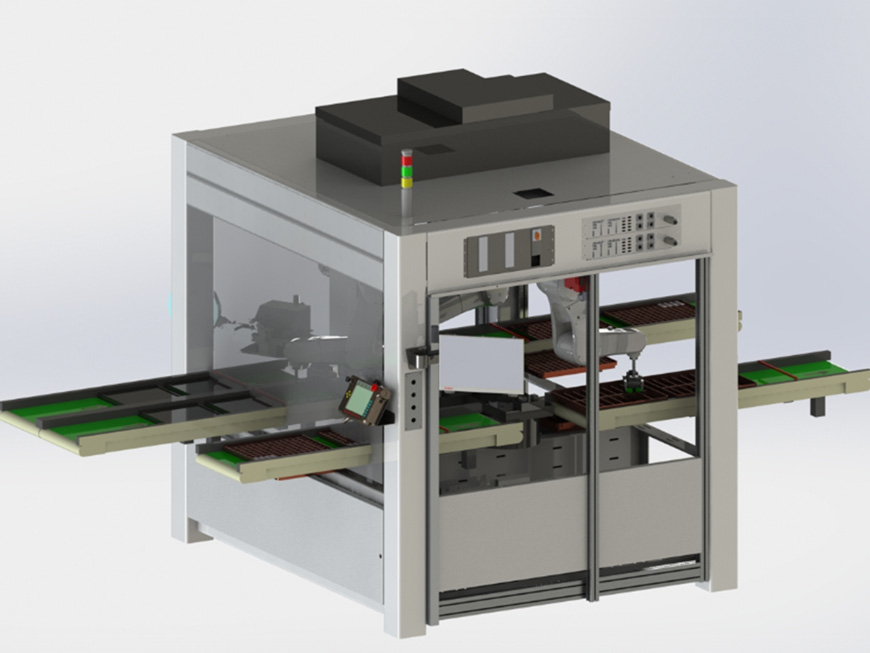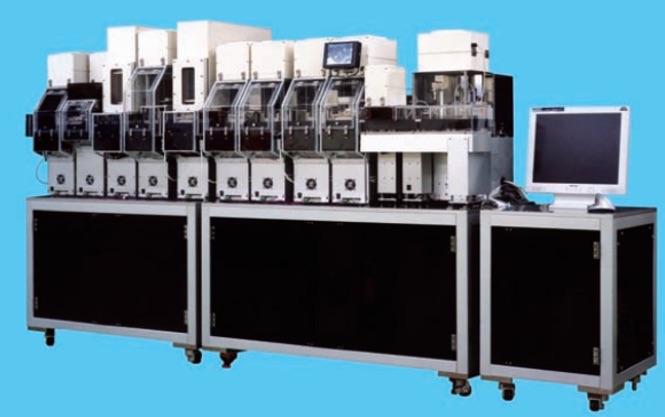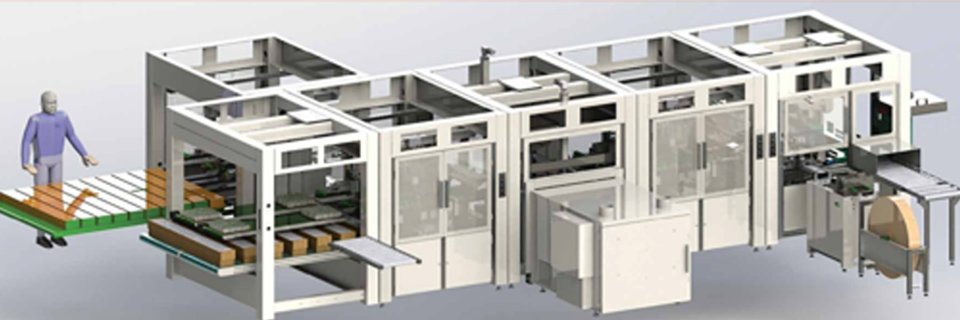The microfactory term was coined in Japan in 1990. In three decades, this manufacturing concept has evolved to a commercially viable alternative for traditional manufacturing and used by several manufacturers successfully world around. However, the term is not yet standardized, and many production technologies are dubbed a microfactory. This blog gives a full inside-out explanation of, e.g., what are microfactories, how do they work, which are the different types, when to deploy a microfactory, and which are the best examples of microfactories.
What is a Microfactory?
The microfactory concept is not standardized. In fact, it is a relatively loosely defined manufacturing concept. EID Robotics defines a modern, automated microfactory as follows:
A microfactory is a manufacturing, assembly, or production unit producing low volumes in a smaller footprint than traditional factories. Microfactories are typically highly automated and robotized to increase capacity and quality while reducing costs through minimized investment and operational workforce. Microfactories are controlled and managed with software operating systems. Big data is collected throughout the process in real-time for predictive fault detection, maintenance, and performance and quality improvement.
Due to their reduced dimensions, most microfactories are used for small batch production of a wide variety of products instead of traditional mass production. The produced items are usually of small form-factor and low weight. Microfactory configurations are built of various functions such as automatic machine tools, CNC tools, robotic arms, assembly systems, quality inspection systems, material feeders, guides, waste elimination and collection systems, packaging and marking applications, and solutions for monitoring tools’ conditions, process performance and more.
The microfactory’s main advantages are to save a significant amount of resources, including space, energy, materials, and time. Microfactories require less equipment and capacity than traditional factories, reducing initial investment, ramp-up time, and operational costs radically.
Microfactory vs. Traditional Factories

An example of a one-module microfactory developed by EID Robotics.
Microfactories and traditional factories are based on opposite underlying principles. Traditional manufacturing advocates concentrating production into a minimized number of large factories to achieve economies of scale and massive production volumes. An enormous demand for products is a prerequisite to warrant the significant initial investment and extensive operational costs to absorb the entire production. In traditional manufacturing, products are typically produced to stock – i.e., large quantities of items are manufactured and distributed to the markets through global retailing channels, stored, and sold to customers.
The microfactory concept turns the manufacturing philosophy upside down. Multiple small yet highly efficient manufacturing units are strategically placed close to the markets. These distributed manufacturing units can produce small batches and a high product mix. The manufacturer can change product design quickly, at minimum cost, allowing production in small batches with different specifications – as opposed to large batches and long runs of highly standardized products in the traditional approach. In the microfactory concept, products are manufactured on customer order – i.e., upon receiving confirmed orders from the customer, without carrying an inventory of finished products.
Microfactory Scalability
Microfactory doesn’t necessarily mean small capacity. Especially modular microfactories can be easily expanded by adding more modules, or new lines to scale production capacity, or product variants, efficiently, allowing manufacturers nearly an unlimited volume and flexibility. Modular structure enables manufacturers to begin with a small capacity and grow based on the demand, minimizing the initial investment and risk.
Microfactory History

Microlathe developed by Mechanical Engineer Laboratory (MEL) of Japan (image credit: futurebridge.com)
The term microfactory was proposed for the first time by the Mechanical Engineer Laboratory (MEL) of Japan in 1990. MEL spent almost a decade developing small machine tools and manufacturing systems. In 1996, MEL introduced a microlathe, a tiny manufacturing system of the size of a human palm. MEL continued development of a prototype for an entire machining factory with a reduced size. In 1999, it introduced the world’s first desktop-sized fabrication system for producing micro ball bearings. Since the development of the first microfactory, these automation technologies have advanced radically, providing applications in multiple commercial manufacturing processes.
Microfactory Examples
Several types of modern manufacturing concepts are commonly referred to as microfactories – including job shops, 3D printers, CNC machines, and various kinds of desktop-sized manufacturing units. In fact, the microfactory concept is not standardized. The following sections introduce five examples of modern manufacturing concepts commonly referred to as microfactories.
Job Shop
Job shops are small, partly manual, and automatized production units handling custom or semi-custom jobs and processes for small batches or custom orders. Typical job shops can provide their customers with CNC tooling, grinding, polishing, deburring, welding, or laser cladding, fulfilling one part of their end-to-end process. They can deliver products or services for various industries with similar requirements – such as marine, aircraft, and machinery.
3D Printing and Additive Manufacturing
3D printing, a.k.a. additive manufacturing, means constructing products based on a digital 3D or CAD model. A robot casts objects layer by layer, e.g., plastic and metal. Due to the vast advancements in 3D printing technologies, complicated products can be produced quickly and cost-efficiently for small batches or custom orders.
Desktop Factory

Desktop factory example (image credit: futurebridge.com)
Desktop-sized automated manufacturing systems can integrate additive, subtractive and other manufacturing technologies into a single process with tool changing for producing small form-factor items.
Automated Microfactory
An automated microfactory refers to a fully automated and robotized manufacturing and assembly line with a wide range of tools and applications chained along the production process. It occupies only a small or medium footprint and can produce a high product mix cost-efficiently with minimum operational resources. This is perhaps the most prevalent notion of the term microfactory today.
Modular Microfactory

An example of a modular microfactory developed by EID Robotics.
In a modular microfactory, the production line is built up from modules, integrated through standard interfaces, allowing rapid installation, flexible scaling, and easy configuration changes at any point of its life-cycle. The ANT Plant is an example of a genuinely modular microfactory platform, allowing custom production lines built from modules, each containing a specific application. Standardized interfaces enable combining modules based on specific requirements, allowing manufacturers to install a microfactory quickly, even in one day, expanding it flexibly, and changing configuration when needed – as opposed to the normal monolithic microfactories, which are designed and built from scratch based on manufacturer-specific requirements.
Most Suitable Deployment Scenarios for Microfactories
Microfactories are a flexible alternative for traditional factories. The ramp-up time is fast, minimizing the initial investment costs and risks. Full automation reduces operational costs and improves quality. But, which deployment scenarios and manufacturing strategies best warrant an investment in a microfactory? There are several reasons why manufacturers set up an automated microfactory; however, the following sections introduce the three main deployment scenarios providing the best fit for a microfactory.
- Local Manufacturing
Local manufacturing strategy means moving production closer to the most important markets. Manufacturers embark on local manufacturing for several reasons – to reduce supply-chain costs, inventories, business risks, and time-to-market. A fully automated microfactory is a critical enabler for local manufacturing – it allows manufacturers to minimize the initial investment, risks, and operational costs. Automated production and small footprint reduce energy consumption and ensure the highest possible product quality. Local manufacturing has a significant sustainability effect in reducing pollution from shipping. In fact, one large cargo-ship of 300-400 meters of length can produce as much pollution as 50 million cars, and the 15 largest mega-ships pollute as much as all the cars in the world.
- Reshoring Manufacturing
The reshoring manufacturing strategy involves bringing the manufacturer’s existing offshored production back to its original home country. The benefits of reshoring include tax incentives, quality improvement, shorter lead times, reduced inventories, faster delivery time, skilled workers, and better protection of intellectual property. Locally produced products eliminate import duties and reduce transportation costs, increasing profitability. A microfactory is the perfect solution for manufacturers to restore production in the home country.
- Rightshoring Manufacturing
Reshoring all production to the home country is difficult and costly in most cases. Rightshoring strategy enables manufacturers to relocate only selected parts of the production to optimal locations best supporting their business. The global coronavirus pandemic has increased interest in reshoring, rightshoring, and local manufacturing. Manufacturers want to avoid supply-chain disruptions and shortages of raw materials and products. Automated microfactory helps them distribute production, reduce risks, and improve the return on investment (ROI) of reshoring, rightshoring, and local manufacturing.
Microfactory Shipment and Installation
One of the main benefits of microfactories is easy, fast, and cost-efficient deployment – the on-site installation time of a microfactory can be as quick as one day, as opposed to months or years with a traditional factory. Fast deployment, however, requires a carefully planned delivery process, including thorough analysis, detailed system design, full off-site pre-installation, and end-to-end testing before it is shipped to the manufacturer’s site.
A modular microfactory line can be easily dismantled into separate modules for the duration of shipping. The modules can be loaded on standard pallets and containers for transportation – special traffic arrangements are typically not needed. The modules can be transported to the manufacturer’s site with a regular truck, and discharged, and placed at the right positions with a forklift. The modules contain the applications during the shipping, so the supplier can start integration right after unwrapping the packages.
Safety Considerations
Safety is a crucial design consideration at sites with automated robotic equipment; manufacturers must pay special attention to make collaborative robots truly safe when the operational staff works close by. A proper risk analysis must be conducted for production lines featuring robotic arms, collaborative robots, and other similar devices. It is not enough that the collaborative robot is safely installed and guarded; also, the gripper, handled object, and the operating environment can cause unexpected risks. The safety plan should also address who is responsible when a robot injures a worker, although in most cases, the manufacturer is held accountable for the safety.
Benefits of Microfactories
Many manufacturers are investing in a local or distributed microfactory concept instead of building a single mass-production plant. Why is the transition to microfactories taking place now? Several aspects advocate microfactory deployments – these include the rapidly changing business landscape, frequent supply-chain disruptions, and growing consumer demand for more personalized, custom-design products. Here is a rundown of the main microfactory benefits.
- Increased innovation through testing new product ideas cost-efficiently on a small scale
- Minimized initial investment and ramp-up time
- Increased Product Quality through automated production
- Supply-chain optimization reducing delivery time, working capital, logistics costs while increasing resiliency against global disruptions
- Customized mass-production of personalized products and regional and seasonal variants
- Cost savings through a limited floor space, small operational staff, reduced consumption of energy, and raw materials
- Immaterial property rights (IPR) protection
- Faster delivery time
- Higher Sales Margin from the price-premium of locally made products
How to Learn More about Microfactories?
Contact EID Robotics to determine whether a modular microfactory is the right choice to support your production strategy. You can download our guide to find out how to build a modular microfactory quickly.
![Microfactory Overview for Manufacturers [Examples, Installation, Deployment Scenarios, Safety]](https://eidrobotics.com/wp-content/uploads/2018/09/artikkelitesti.jpg)
